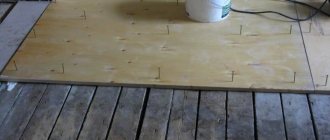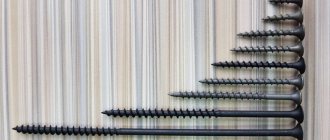Preparatory stage
Before winding flax or tow on the thread, you need to prepare the joint surface and determine the required amount of tow. Screw the fitting onto the thread as is, without wrapping anything. This will help determine how much tow you will need to take.
If the thread is smooth and even (in the case of factory threading, most likely this will be the case), it is recommended to apply notches on the threads for better adhesion. For this, a water wrench, a triangular socket or regular pliers are suitable; all you need to do is apply notches across the thread, without being too zealous. This is done in order to prevent the tow from sliding along the threads.
The notches should not be too deep; you do not need to literally pierce the metal (watch the video). The reliability of the connection in the future will depend on how the tow is wound correctly. If you put too little and rarely, it will leak, but too much can be much more dangerous - a wound area that is wrapped too tightly can burst when the temperature rises (as you know, metal expands when heated).
General information
Since every home craftsman has at least once encountered the problem of winding flax onto a tap thread, you should learn how to do this. If you want to hermetically connect each element of the water supply and pipes, then you should perform packing. To do this, two pipes must be packed at an angle of 90 degrees using a coupling, and there must be a thread at the end of each pipe. The coupling will have internal threads as well as external threads. Twisting alone is not enough, so for the best connection, sealing should be done.
Description of flax (tow)
Before you start winding flax onto pipes, you should become more familiar with what flax tow is. This is a fibrous type material that is used to seal threads. The product is natural, it is made from the primary processing of homogeneous, thin and long-fiber flax. The scope of application of the material is wide. Depending on the manufacturing method, the material can be tape, jute, plumbing or construction. In our case, we will talk about insulation, which makes it possible to reliably seal each connection.
To make this material, combed fibers are used, which are brought in bales. They are used for construction work when sealing seams, insulating a log house and laying wood elements. The material is natural, and this is especially valuable among those people who are building a wooden house. If rolled material was used to connect pipes with flax, then it can be called tape. This material is also used to caulk seams in log houses and lay crowns. The advantage of using flax is the cost, since the material for plumbing work is several times cheaper than other analogues. In addition, it is economically consumed, and the fibers, although thin, are very strong. If they are wound correctly, they can be used for various types of work where any type of connection will be used. Can be used for cast iron and ceramic pipes.
Advantages
Before you start wrapping flax on the thread, you should know that it begins to swell and absorb moisture, which allows you to increase the level of tightness, since there will be no way for leakage. In addition, the material has high mechanical stability, and it is this characteristic that makes it possible to adjust plumbing fixtures, and the hermetic properties will not be lost; connections can be unscrewed by half a turn or a full turn.
Disadvantages of use
If you are thinking about how to wind flax on a thread, you should first become familiar with all the shortcomings of the material. So, the material is based on a substance of organic origin, and therefore it can begin to rot when exposed to moisture and air. Also, it sometimes gets inside even during a routine examination. To do this, when using tow, you should also use another material, additional, which will help prevent the rotting process. This can be sealing paste, oil paints, solid oil or lithol.
Sometimes, before winding, you should first prepare the thread, since if you lay the material in a large layer, then there is a possibility of damage to the joints, and this is especially true for bronze and brass. If you are faced with the question of how to wind tow on a threaded connection, then you should remember that such a seal requires knowledge of the rules of winding.
Additional materials in combination with tow will make further disassembly difficult, and this applies to oil paint and silicone. Sometimes such additions make the installation process completely unbearable. It is not suitable to use flax when the temperature reaches +90 degrees. In such places, the material begins to weld, and then completely loses its sealing properties. If you are dealing with steel, then you should definitely follow the winding technology, as otherwise the thread may be subject to corrosion.
Let's start winding
A small amount of tow should be taken from the total bunch, and the fibers should be even, smooth, without knots or breaks.
The tow needs to be twisted into a rope of such thickness that it (thickness) is equal to the pitch of the thread, that is, it fills the cavity between the turns.
Winding is carried out from the inner edge of the thread;
There are several ways to wind tow - for example, some advise starting winding with an indentation and then overlapping the fibers so that they hold better (see video).
But for beginners it will be easier to wind directly from the edge.
So, by attaching the end of the linen rope to the first turn, we wind in the direction opposite to the twisting direction - that is, clockwise if the thread is right-handed (in the vast majority of cases this is the case).
You need to wrap it tightly, but not too much - two layers will be more than enough. As soon as you have wound the tow on the thread, you should, without letting go of your fingers, apply the paste to fix it. Silicone, paint or glue are often used for this, but from personal experience we recommend paying attention to “Unipak” - this paste is more neutral with respect to metal and has no taste or smell, which will help avoid problems when installing water pipes.
How to use plumbing flax (tow)
Using plumbing flax (tow) is very simple. To do this, you must meet the following requirements:
- ✅ Clean the thread with a metal brush, and if the tow wraps around the colored thread, then you should use pliers to make notches on it. This will not allow the plumbing flax to peel off when screwing on nipples, bends, tees, and other fittings.
- ✅ After the tow is wound on the thread, it needs to be lubricated with a special lubricant for plumbing flax. One of these means is “Unipak”, which preserves tow well and protects it from rotting during the operation of pipes and fittings.
- ✅ To wrap the tow on the thread, you need to tear it off in a small amount from the whole “braid”, and then twist a thin rope.
- ✅ Then, from the beginning of the carving, you should wind the tow clockwise so that it fills the turns. You should not wrap too much tow, as this will seriously complicate the tightening of the fittings. In addition, brass and bronze fittings may not withstand serious expansion, and will simply burst during the tightening process.
- ✅ Finally, you should screw the fitting onto the thread using keys, reliably sealing the threaded connection.
Important advice: sometimes, in order to find out how long it is worth screwing a fitting onto a thread, it is better to screw it on without first winding the plumbing flax, while counting the number of thread turns.
As a rule, these manipulations are quite enough to qualitatively seal the thread with plumbing flax, while the threaded connection can withstand pressure of 10 atmospheres or more.
How to wind flax on a thread?
Hello dear homemade people.
Until now, the best winding for thread is linen. First, I will justify this statement, and then we will analyze the execution process piece by piece.
The first alternative to flax is fum tape. There are at least three reasons why it should be abandoned.
1. It is unknown who made it, despite what is indicated on the label, which means there are no guarantees of quality.
2. It takes a long time to wind it.
3. When tightening the thread, especially when installing valves, it is impossible to correct its position, that is, you can only tighten it forward. If you push it back a little, the connection on the gun will leak.
The second alternative is a Tangit unilock pipe with a lock. I won’t argue about the lock - it’s dead, but as for the key: consider that they screwed it up and threw the key away, so you can’t find it.
You can't unscrew it, you can only cut it.
Linen is a completely different matter.
Here are four reasons why it's worth using:
1. One hundred percent guarantee against leakage.
2. Speed and accuracy of execution.
3. The ability to adjust any connection back and forth, without the risk of leakage.
4. Easy disassembly, regardless of service life.
Now how all this is done.
Everyone knows that flax is not wound dry. Previously, it was impregnated with paint, but now, thanks to technological progress, silicone has appeared.
If the connection with paint looked very untidy, and you had to disassemble it with a blowtorch, then with silicone it was a completely different matter.
The main thing is to use solid silicones. These include: KimTek 101E, Olimp, Macroflex, since they, in addition to cushioning, also have adhesive properties. With other brands, the connection turns out to be too flexible, although it still does not leak.
So, we take a part with a thread, a flax braid, a syringe with silicone, and separate a small part from the braid for winding.
How much to pinch off from a braid? Each case is different. First you need to try wrapping the folder in a case. Sometimes it wraps very easily, sometimes it wraps tightly (just like in life), and depending on this, the amount of winding is selected.
But in general, after the first time it will become clear. If it squeezes out too much, then take less.
First, we apply silicone to the thread, then, leaving a small tail, and pressing it with your thumb to the part, in the direction of the thread, we tightly wind the flax, trying to cover the entire surface with it, that is, so that it does not go in a strand.
If during the winding process you realize that there is already too much flax, simply tear off the rest. We also run the remaining tail in the direction of the thread.
After that, with your finger, we smooth the entire winding so that the hairs do not stick out on the sides, and most importantly, do not block the passage hole.
Now we wrap it, making sure that part of the winding is squeezed out. It can be easily removed with a rag, and the harder you press the rag against the part, the more accurate the connection will be.
Personal finance management. For those who value Time, their Nerves and Money - building Big Plans
How to wind flax (tow) on a thread?
The debate about what is better to use as a sealant for threaded connections (windings) - flax or fum tape - has not subsided for years. This situation is explained by the fact that it is impossible to give an unambiguous answer to this question. For each type of work, either flax or fum tape is preferable. And often the recommendation of one does not exclude the use of an alternative sealant. If plumbers cannot come to a common opinion among themselves, what can we say about non-professionals? But even mere mortals sometimes need to connect something together. And it’s hermetically sealed. I’ll try to break down the recommendations “on the shelves”.
Which is better: linen or fum tape?
When it comes to sealing threaded connections, the first thought that comes to mind is plumbing. When installing a cold water supply system from steel pipes, neither flax nor fum tape have any obvious advantages. The main thing is to wind the seal correctly.
But when this water supply is installed from plastic or metal-plastic pipes, fum tape is preferable. Its advantage in this case is explained by speed. Non-metallic water pipes are installed faster than steel ones. And reducing the installation speed just because of rewinding (and rewinding flax is more difficult and takes longer) is not effective. In addition, the threads of the fittings are smooth and neat, and in such conditions fum tape is more effective.










